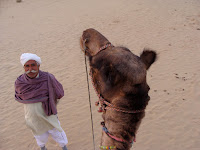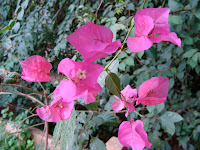I visited a number of forts and palaces in North India, and took many pictures. The architectural detail can be amazing - please double click any of the photos below for a closer view of the artistry.
Fatehpur Sikri, or the City of Victory, was built by the emperor
Akbar starting in 1571, near the city of Agra. It served as the capital of the Mughal empire until 1585, when it was abandoned. It is believed that the water supply was not reliable enough to support the residents. The well-preserved buildings were designated as a UNESCO World Heritage Site in 1986.
Musicians would perform for the court on the platform in the middle of this pool, with the water acting as a natural amplifier.
Nobles might play a game of parchesi, with dancing women moving from space to space.
Wine was also known within the palace walls.
Intricate bas reliefs decorate the living quarters. Religious sensibilities, in a state of flux during and after the rule of Akbar, influenced design. He encouraged religious moderation and tolerance, by hosting theological debates and through the example of his own interfaith marriages.
The panel immediately below, with plants as its subject, has been preserved, but in the panel further below, the faces of the animals have been excised, in deference to certain Muslim beliefs prohibiting the depiction of faces in art.
My understanding of the prohibition comes from one of the students I tutored in Toronto a few years ago. The belief is that while angels make the bodies of animals and people, God Himself makes the faces. One must take care to never do anything that could show disrespect towards God's work. Any human attempt to represent the work of God could only fall short.
As part of the complex, Akbar built one of the largest mosques in India. This is the main entrance to the mosque.
This is a view of the other side of the main entrance, as seen across the central courtyard. Graves are visible in the foreground.
This is one of the most beautiful arcades I saw in India.
The Agra Fort has been in existence from at least the 11th century C.E. The Mughul emperor Akbar assumed control of the fort in the 16th century and began to rebuild the ruined brick structure using red sandstone. This phase of work began in 1565 and ended in 1573.
Akbar's grandson Shah Jahan, builder of the Taj Mahal, continued to make additions to Agra Fort. Eschewing the cheaper red sandstone favoured by his grandfather, Shah Jahan built palaces of white marble inside the fort, carved with bas reliefs and inlaid with gold and semi precious stones, much like the Taj Mahal.
Shah Jahan dreamed big dreams, and appeared to have an inexhaustible supply of them, although his empire did not have an inexhaustible supply of money to build them. This was probably one of the concerns of
Aurangzeb, the third son of Shah Jahan and Mumtaz Mahal. In a nasty battle of succession with his family, he imprisoned his father in the Agra Fort for the last seven years of his life, from 1657 to 1664. As Aurangzeb went on to rule the Mughal empire, his father would gaze out of his sumptuous prison at his beloved Taj Mahal, with thoughts we can only imagine.
The Amber Fort has existed since the 10th century C.E. It was ruled by the Kachwaha clan of Rajputs from about 1037 to 1727, when Sawai Jai Singh II moved his capital to the newly created town named after him, Jaipur.
The fort formed a central part of a vast network of sandstone walls protecting the town of Amber.
This section of the palace was richly painted centuries ago. The colours remain vivid, both on the exterior and the interior.
Another part of the complex is known as the Palace of Mirrors.
Thousands of tiny mirrors cover the walls of this stunning suite of rooms. It is said that a single candle could light the interior at night, and that the mirrors would shine like a starlit sky.
This part of the palace also has some rare examples of Hindu stained glass. I met an artist at the site who specializes in restoring it,
Pushpendra Singh Rathore.
During the heat of the summer, royal residents of the palace could relax in a shaded pavilion. A stream of water would flow down a ridged incline then through a channel in the floor, creating a soothing sound and a cooler ambient temperature, before it continued through to a lush garden.
In the arid hills of Rajasthan, obtaining steady supplies of water required planning and work. Water would be pumped into cisterns using draft animals as the source of power. The Amber Fort made use of a Persian Water Wheel, or Rehat, to draw water from cisterns for further distribution. Earthenware jugs were attached to a looped pair of ropes. The jugs would descend into the cistern to fill and as they were brought back up over the top, would empty their contents into the appropriate channels.
The ropes moved on an axle, powered by a shaft, which in turn was powered by ...
... slave labour, supplied by whichever people had been conquered by the ruler of the time.
Feeding everyone in the fort would be a huge daily task, with cooking pots up for the challenge.


























































